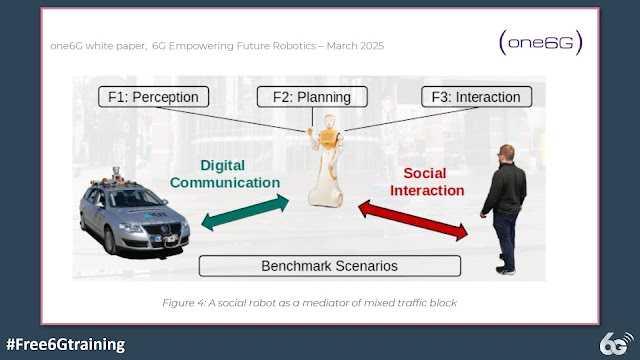As 6G research accelerates, the need to ground its ambitions in real-world applications becomes increasingly clear. The one6G Association’s latest white paper, “6G Empowering Future Robotics,” offers a deep dive into how the next generation of wireless networks will transform robotic systems—from individual machines to coordinated swarms—across a wide range of verticals.
Unveiled at the European Robotics Forum 2025, this white paper goes beyond theoretical exploration. It systematically maps robotic requirements onto the evolving capabilities of IMT-2030 and presents an architectural vision for integrating communication, sensing, computing, and control. The paper is also endorsed by euRobotics and participants of the IEEE P1955 Working Group, underscoring its relevance across the robotics and telecom domains.
Understanding Robotic Requirements in the 6G Context
Robots today are being deployed in increasingly dynamic and complex environments—factories, farms, hospitals, disaster zones, and even in our homes. To function effectively, these systems require four tightly coupled capabilities: sensing, cognition, planning and actuation, and self-learning.
The paper defines these as high-level functional building blocks and details how 6G can support each:
- Sensing and Perception: Real-time environmental understanding depends on high-resolution data from multiple sources. 6G’s integrated sensing and communication (ISAC) capabilities can dramatically enhance context awareness and precision, especially in GNSS-denied or cluttered environments.
- Cognition and Reasoning: AI-enabled control logic running locally or at the edge must interpret sensor data, predict changes, and support real-time decision-making. 6G’s edge-cloud continuum enables this with reduced latency and higher compute availability.
- Actuation and Execution: With HRLLC (Hyper Reliable Low-Latency Communication), actuation becomes safer and more precise, whether for robotic arms in manufacturing or for surgical robots in healthcare.
- Self-Learning: Robots can learn from past interactions and adapt to new environments. Federated learning over 6G networks allows collaborative model updates without violating data privacy constraints.
From Concepts to Capabilities: Emerging Trends in Robotics
The white paper explores new and emerging paradigms in robotics that place even greater demands on communication systems:
- Soft Robotics: Flexible, bio-inspired systems require low-latency and high-reliability communication for safe and adaptive interaction in variable environments.
- Swarm Robotics: Multi-robot coordination for logistics, search and rescue, or surveillance is enabled by D2D links, dynamic network topologies, and low-power wireless designs.
- Human-Robot Collaboration: Use cases such as exoskeletons and Dual User Shared Tasks (DUST) demand shared control frameworks with real-time feedback, context recognition, and ultra-reliable connectivity.
All of these concepts depend on a communication fabric that is adaptable, intelligent, and resilient—qualities that 6G aims to deliver.
Mapping Robotics onto IMT-2030
A core contribution of the paper is the mapping of robotic application demands onto IMT-2030’s expected capabilities:
- eMBB → Immersive Communication: Enabling multi-sensory human-robot interactions, including vision, sound, and haptic feedback for tasks like remote surgery, XR-based telepresence, and real-time industrial collaboration.
- mMTC → Massive Communication: Supporting dense deployments with thousands of connected devices—robots, sensors, and actuators—while ensuring energy efficiency and low protocol overhead.
- URLLC → HRLLC: Delivering sub-millisecond latency and near-perfect reliability for critical robotic tasks, from dynamic object avoidance to precise manipulation in complex scenarios.
6G will also bring in ubiquitous connectivity through terrestrial and non-terrestrial networks (NTNs), extending robotic operations to remote or hostile environments—underwater, underground, in disaster zones, or on remote farms.
6G Enablers for a Robotic Future
In addition to evolving existing service classes, 6G introduces several novel enablers that are highly relevant for future robotics:
- Integrated Sensing and Communication (ISAC): Allowing the same radio signals to provide both connectivity and environment mapping, enabling capabilities like real-time SLAM, hidden object detection, and collaborative awareness.
- Semantic Communication: Transmitting only the "meaning" of the data rather than raw packets, reducing bandwidth use and improving efficiency in swarm robotics and edge AI scenarios.
- AI-Native Networks: From predictive scheduling and energy management to context-aware adaptation, 6G networks will embed intelligence throughout the stack.
- Edge-Cloud Continuum: Supporting distributed inference and model training close to the robot, ensuring fast response and reduced dependency on centralised processing.
Ethical, Security, and Sustainability Imperatives
The white paper takes a holistic approach, addressing the ethical and environmental dimensions of 6G-enabled robotics. Key considerations include:
- Privacy: Robots operating in public or private spaces must process data securely and respectfully.
- Security: As robotic systems become more critical, they become targets. Robust cyber-physical protections will be essential.
- Sustainability: With energy efficiency being a top priority for both 6G and robotics, shared goals like efficient hardware, green protocols, and lifecycle management are key.
Standardisation and Multidisciplinary Collaboration
Finally, one6G stresses the importance of collaboration across domains. Whether it’s defining network exposure functions in 3GPP for robotic applications, or aligning AI ethics principles in standardisation bodies, convergence between telecom and robotics is now essential.
The paper also encourages further research and demonstration of 6G-enabled robotics, especially to validate commercial feasibility and explore new protocols optimised for real-time robotic performance.
Final Thoughts
The “6G Empowering Future Robotics” white paper is a major step forward in aligning the vision of IMT-2030 with tangible, high-impact use cases in robotics. By addressing technical, architectural, and societal aspects, one6G offers a comprehensive guide for how the next generation of wireless can power the next generation of machines.
Whether you're designing communication protocols, building autonomous robots, or working on the policy side of emerging tech, this white paper provides a compelling and technically rich foundation for understanding the 6G-robotics synergy.
You can read the full white paper here.
Related Posts
- Free 6G Training: one6G Open Lecture 8 – Next Generation MIMO
- Free 6G Training: one6G Open Lecture 7 – In-Network Computing and Intelligent User Plane for 6G
- Free 6G Training: one6G Open Lecture 6 on 'Sustainability in 6G'
- Free 6G Training: Videos and Slides from one6G Summit 2022
- Free 6G Training: one6G publishes '6G Vertical Use Cases' whitepaper



Comments
Post a Comment